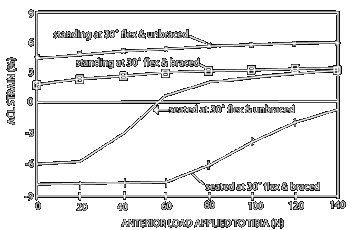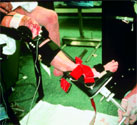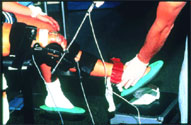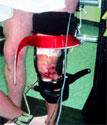Biomechanics Lab - Clinical Studies
AN IN-VIVO INVESTIGATION OF ANTERIOR CRUCIATE LIGAMENT STRAIN: THE EFFECT OF FUNCTIONAL KNEE BRACING AND ATTACHMENT STRAP TENSION
Beynnon BD, Fleming BC, Peura GD, Johnson RJ,
Renstrom PA, Nichols CE, Pope MH
Dept. of Orthopaedics, McClure Musculoskeletal Research Center
Stafford Hall, University of Vermont, Burlington, VT 05405-0084
Introduction: Functional knee braces are widely used in subjects who have disrupted their anterior cruciate ligament (ACL), or have undergone an ACL reconstruction, despite the fact that few scientific data support their efficacy. Previous studies have demonstrated that for low anterior loads applied to the tibia and small internal tibial torque magnitudes a functional brace can control tibiofemoral motion to the extent that normal ACL strain values are reduced, and abnormal tibiofemoral translations and rotations are prevented; however, the ACL strain values were not affected by bracing at the high anterior loads and internal torques that are expected to occur during athletic events (1). These previous studies did not control the brace design, the technique of brace attachment, and the variables at the brace limb interface. The objectives of this investigation were: to control these variables and quantify ACL strain when loads were applied to a knee fitted with a functional brace; to determine if bracing produces a protective effect on ACL strain with different anterior tibial tuberosity strap tensions (applied to produce a posterior directed load on the tibia that may reduce ACL strain); and to determine if bracing reduces ACL strain with the compressive load of body weight across the knee.
Methods: The investigation received full approval of the Institutional Review Board, and all subjects consented to participate. The sample size consisted of 4 subjects with normal ACLs who required a minor arthroscopic procedure under local anesthesia. After their required surgery, a Differential Variable Reluctance Transducer (DVRT: MicroStrain Co., Burlington, VT) was implanted into the anteromedial band of their normal ACL. Each subject then sat upright on the operating table with the femur supported in the horizontal plane and the tibia hanging free. Evaluation of the DonJoy Goldpoint brace (Carlsbad, CA) consisted of three different test series. First, the knee was positioned at 30º of flexion and a torque boot was applied to the foot, enabling the investigator to apply internal and then external torques about the long axis of the lower leg.
The second series required the subject to remain in the seated position and a load sensor was used to apply anterior-posterior directed loads to the proximal tibia relative to the fixed femur.
The third test series required the subject to stand beside the operating table bearing weight equally on both legs with the knees flexed to 30º. The upper thigh was strapped to a support that maintained the knee at 30º of flexion while the investigator used the load sensor to apply anterior-posterior loads to the tibia as described in the second test series.
For all subjects, each of the three previously described test series was applied on the unbraced knee, on the braced knee with the anterior tibial tuberosity strap tensioned to 22 N, on the braced knee with the anterior tibial strap tensioned to 45 N, and then the unbraced knee was retested to allow a repeated normal comparison. A randomized complete block experimental design was used, facilitating comparisons of ACL strain values for each test series between: 1) the unbraced and the braced knee treatments; 2) the braced knee with a high anterior-tibial strap tension and a low anterior tibial strap tension; and 3) the unbraced and the repeated unbraced treatments. The statistical analysis was multiple range comparison ANOVA at a selection of applied anterior shear loads, or internal-external tibial torque values.
Results: Knee bracing significantly decreased ACL strain values in comparison to the unbraced condition for internal-external tibial torque magnitudes up to 5 Nm (p=.005). In addition, there was no significant difference in ACL strain values between bracing with a high anterior-tibial strap tension and bracing with a low strap tension. Anterior loading of the tibia with the subject in the seated (unweighted) position produced ACL strain values that were significantly less for the braced knee in comparison to the unbraced condition between the load limits of 0 and 140 N (p=.005). For anterior loading of the tibia in this unweighted test, there was no difference in ACL strain values between bracing with a high anterior-tibial strap tension and bracing with a low strap tension. For the standing condition (weighted) combined with applied anterior loading of the tibia between 0 and 140 N, there was a trend indicating that the ACL strain values were less in the braced knee in comparison to the unbraced condition (p=.06); (Fig. 1). Again, changing the anterior tibial strap tension produced no effect on ACL strain values. For all three test series, there was no difference between the pretest unbraced and the post-test unbraced conditions.

Discussion: This investigation was designed to study the effect that anterior-tibial strap tension of a functional brace and the compressive load produced across the knee by body weight has on ACL strain behavior.
Our results indicate that for the knee in the unweighted condition (the seated subject) the brace can reduce ACL strain values for internal-external torque applied to the tibia up to 5Nm, and for anterior directed loads applied to the tibia up to the limit of 140 N. For the standing subject with the knees flexed at 30º the brace produced a similar effect by decreasing ACL strain values, although by a smaller magnitude.
Normal (Unbraced) 1 2 3 22N tibial strap tension 1 2 3 45N tibial strap tension 1 2 3 Normal (Unbraced) 1 2 3
| TREATMENT | LOADING ACTIVITY |
|
|
Normal (Unbraced) | 1 | 2 | 3 | |
22N tibial strap tension | 1 | 2 | 3 | |
45N tibial strap tension | 1 | 2 | 3 | |
Normal (Unbraced) | 1 | 1 | 3 |
This may be attributed to the interaction between the tibiofemoral compressive load and joint geometry. At the onset of this investigation we thought that the posterior directed loads on the tibia produced by the higher (45N) anterior tibial tuberosity strap tension would result in smaller ACL strain values in comparison to the brace with a relatively lower strap tension (22N). However, for all three test series there was no difference in ACL strain values between the high and low anterior tibial strap tensions. It may be that the effect of the anterior-tibial strap tension on the ACL is offset by the soft tissue compliance at the other regions of attachment of the brace to the lower limb. Our pretest and post-test monitoring of the unbraced knee has assured us that the measurement technique was reproducible.
Reference: (1) Beynnon et al.: JBJS 74A:1298-1312, 1992
Acknowledgment: NIH grant RO1-39213 and Smith & Nephew Inc. DonJoy Division.
The authors do not own or will not derive profit from the material described in this abstract.
Bruce Beynnon, Ph.D., Dept. of Orthop., Stafford Hall, Univ. of Vermont, Burlington, VT 05405-0084, ph. (802) 656 4248, fax (802) 656 4247, email address: beynnon@salus.med.uvm.edu
41st Annual Meeting, Orthopaedic Research Society, February 13 - 16, 1995, Orlando, Florida
Click on images below to see an enlarged view:
| Strain guage implanted into anterior medial band of ACL |
| Interior/exterior torque applied to tibia (subject seated) |
| Anterior/posterior load applied to tibia (subject seated) |
| Anterior/posterior load applied to tibia (subject standing) |








